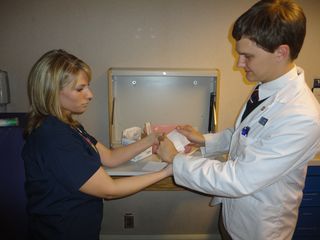
Diana Santangelo demonstrates patient wound care to medical student Stuart Carter.
Wound care on a patient with diabetic foot ulcers. Pulling together information for a patient discharge. They seem like routine activities in any busy hospital but they often remain hidden from medical students learning the ropes; they’re more apt to focus on diagnosing patients and making a plan for their treatment. “These are things you never see when you’re with a resident or attending,” said Ivor Asztalos, second-year student at Penn’s Perelman School of Medicine. But he and other medical students are now getting acquainted with those and many other key patient care efforts, thanks to a new program at Penn Medicine that pairs nurses with medical students who are new to clinical rotations. Leading the way, nurse mentors not only show Penn med students the ins and outs of patient units, but also illuminate the key roles nurses play in patient care.
Stuart Carter, a third-year student, clearly remembered his first few days on Founders 14, a very busy and complex patient care unit at the Hospital of the University of Pennsylvania. “I felt like a deer in the headlights. It was scary, trying to navigate the system.”
Enter Diane Santangelo, the clinical nurse who served as his nurse mentor. Remembering the fear that she too felt on her first clinical rotation as a student nurse, she took the time to show Carter the structure of the floors, and the different responsibilities of nurses and support staff. “It was nice to have someone help ease my burden,” he said. “Now, I feel much more comfortable interacting with the nursing staff.”
This new program is an extension of Penn Medicine’s unit-based clinical leadership initiative. These interdisciplinary groups have demonstrated the immense benefits of health-care professionals working as a team instead of in side-by-side silos. The mentoring program brings them together at an earlier stage … and it’s been a win-win situation for everyone.
“Diana was the point person I could direct questions to,” Carter said. “I had a much better perception of who to go to for answers and as a result I was a more helpful med student.”
Input from groups of nurses and med students helped shape the structure of the mentoring program, said Anna Delaney, the medical school’s chief administration officer. “We asked them, ‘What is it you don’t understand about each other? What has worked well and what hasn’t?” From that feedback came a checklist of nursing actions that were important for medical students to see, including patient admission and discharge, wound care, medication administration, and the nurse-to-nurse shift report.
The biggest surprise, Santangelo said, was how little medical students seem to know about the role of the nurse in patient care. “Sometimes I feel like they think things magically happen!” she said, laughing. “I tell them, ‘These are the steps we have to do to prepare for a discharge … so be nice to me when you’re an intern and I call you 15 times!’”
“The process from the doctor typing an order into the computer to its execution is like an algebra equation; many factors play into it,” explained Ian Villarreal, BSN, another nurse mentor on Founders 14. For example, for medication administration, “we have to know ‘Can the patient swallow? If there are two meds, are they compatible?’ ... There are a lot of subtleties to be learned.”
Med student Asztalos valued the “treasure trove of information” nurses enter into their patients’ electronic medical records from their direct care of the patients throughout the day. “They do a head-to-toe assessment every day and put all this information online,” he said, “but the average med student may not know how to find this information … or that it even exists.”
Based on the positive feedback, every Penn med student who does a rotation in internal medicine will now participate in this interdisciplinary process. Since piloting the program last year on two of HUP’s patient units, it has expanded to include others, including a critical care unit, and labor and delivery, and the Acute Care for Elders unit at Penn Presbyterian Medical Center. “Each unit we choose brings something unique to the table,” said Keith Hamilton, MD, associate director of the Internal Medicine Clerkship. “For example, CCU nurses have expertise in reading telemetry, and the ACE unit demonstrates the nuances in caring for the elderly.” All of those things are areas medical school graduates will need to be familiar with once they begin their residencies. Plans to roll the program out throughout the Health System are now underway.
“Now that health care is a team sport, it’s crucial for medical students to understand the roles of other members of the team,” Hamilton said. “When they graduate, they will be helping to lead these teams. It’s important to ‘grow up’ in this environment.”